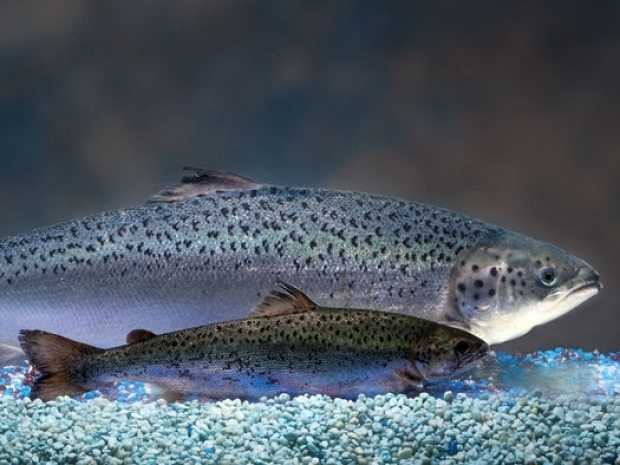After five years of debate, the U.S. Food and Drug Administration approved genetically modified salmon for food.
The AquAdvantage salmon, produced by Massachusetts-based biotechnology company AquaBounty Technologies, is the first genetically modified animal approved for food in the U.S. The salmon is designed to reach a larger size faster than farmed Atlantic salmon by splicing in a gene from Pacific Chinook, which allows the fish to produce more growth hormone.
The FDA determined that genetically engineered salmon is as safe to eat as natural salmon, according to an announcement Thursday. The agency has also released guidance on labeling genetically engineered foods, although it is not a requirement.
“We recognize that some consumers are interested in knowing whether food ingredients are derived from GE sources,” said Susan Mayne, director of the FDA’s Center for Food Safety and Applied Nutrition, in a news release. “The FDA is issuing two guidance documents that explain how food companies that want to voluntarily label their products can provide this information to consumers.”
The fish are currently approved to be farmed in two locations — one in Canada where breeding stock are kept and another in Panama where sterile females only will be grown. The Canada facility will only keep its fish indoors and have screens on the drainage pipes to catch eggs, and if any do escape, there are chlorine pucks to kill any escaped fish or eggs in the main drainage area, according to the FDA.
The difference between conventional salmon farms and the genetically engineered salmon is that they will not be allowed in open-ocean pens. The Panamanian fish will be kept in a land-based facility, and the FDA wrote in its announcement that there are enough physical and artificial barriers to keep them from escaping into the ocean.
Some Cook Inlet fishermen are concerned about the fish escaping into the wild and breeding with the salmon, possibly weakening the genetics of the Pacific salmon stock. When the FDA originally proposed approving the salmon, more than 30,000 individuals and organizations wrote in, including many Alaska organizations.
In 2009, commercial fisherman Joel Doner caught a stray Atlantic salmon in his net near Clam Gulch, the only known Atlantic salmon to be caught in Cook Inlet. The farm fish had reportedly escaped from a farm near British Columbia, and while commercial fishermen sometimes catch them near Southeastern Alaska, that was the first to be caught so far north.
Doner said it was alarming that the FDA would approve the genetically engineered salmon to be sold.
“Obviously, they do escape,” Doner said. “There are thousands upon thousands that escape every year. And they don’t just hang out near where they escape from.”
Gary Fandrei, the executive director of the Cook Inlet Aquaculture Association, said he had mixed feelings about the approval. While the salmon, which grow faster and can be farmed to meet demand, will help feed more people, the consequences of genetically modifying animals is still unclear, he said.
“What we’re doing with a lot of the genetically engineered stuff is that we’re taking what was done with selective breeding and accelerating that,” Fandrei said. “We don’t know the implications of doing that. When you go through on a rapid pace of doing these programs, you don’t understand the implications of what could happen if things don’t go as you planned.”
Alaska banned finfish farming for commercial purposes in 1989 to protect wild salmon fisheries.
Farmed fish are cared for all their lives and can grow larger, without the natural competition of the wild. Some of the fear is that the farmed fish could escape and out-compete wild salmon populations.
Other fishermen have raised concerns about price. The farmed salmon sell for a lower price than wild salmon, which could potentially negatively impact the prices commercial fishermen receive for the salmon they catch.
Alaska senators Lisa Murkowski, Dan Sullivan and Alaska Congressman Don Young all voice objections to the approval Thursday. They said they would push for labeling of the fish as genetically engineered, and Murkowski and Young both introduced bills earlier this year requiring the labeling of genetically engineered fish, nicknamed “Frankenfish” by those opposing the approval. Murkowski also launched an online petition demanding labeling.
Doner said wild salmon prices would likely remain stable in the short term, but in the long term, the presence of cheaper salmon in the market could impact wild salmon prices.
“It’ll affect markets, because I think the whole idea behind is to make growing fish more efficient,” Doner said.
Dave Martin of the United Cook Inlet Drift Association said his main concern was about the labeling of the product. The FDA is suggesting, not requiring the company to label the fish as genetically engineered.
Martin said his main concern was that the labeling be accurate — people should know they are eating genetically engineered salmon, not wild salmon.
“That’s a whole new ball game if it’s not required to be marked,” Martin said. “It’ll just be more mislabeled product as Alaska. Alaska spends a lot of money to promote the Alaska wild salmon sustainable high quality and good flavor. We’ve done a great job doing that. By putting this fish into the system without being required to, and they can call it Alaska salmon, what’s to stop them from not doing so?”
Reach Elizabeth Earl at elizabeth.earl@peninsulaclarion.com.

